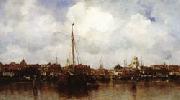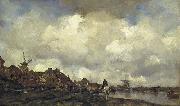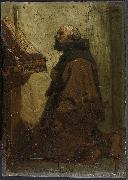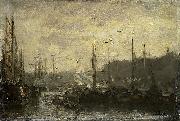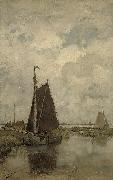Jacob Maris El petróleo que Pinta la ReproducciónAll Jacob Maris Oil Paintings(August 25, 1837, The Hague - August 7, 1899, Karlsbad) was a Dutch painter, who with his brothers Willem and Matthijs belonged to what has come to be known as the Hague School of painters. Maris studied at the Antwerp Academy, and subsequently in Hubertus van Hove's studio during a stay in Paris from 1865 till 1871. He returned to Holland when the Franco-Prussian War broke out, and died there in August 1899. Though he painted, especially in early life, domestic scenes and interiors invested with deeply sympathetic feeling, it is as a landscape painter that Maris excelled. He was the painter of bridges and windmills, of old quays, massive towers, and level banks; even more was he the painter of water, and misty skies, and chasing clouds. In all his works, whether in water or oil color, and in his etchings, the subject is always subordinate to the effect. His art is suggestive rather than decorative, and his force does not seem to depend on any preconceived method, such as a synthetical treatment of form or gradations of tone. And yet, though his means appear so simple, the artist's mind seems to communicate with the spectator's by directness of pictorial instinct, and we have only to observe the admirable balance of composition and truthful perspective to understand the sure knowledge of his business that underlies such purely impressionist handling. |
|||

|
|||
|
|
|||
|
||||||||
| Jacob Maris (August 25, 1837, The Hague - August 7, 1899, Karlsbad) was a Dutch painter, who with his brothers Willem and Matthijs belonged to what has come to be known as the Hague School of painters. Maris studied at the Antwerp Academy, and subsequently in Hubertus van Hove's studio during a stay in Paris from 1865 till 1871. He returned to Holland when the Franco-Prussian War broke out, and died there in August 1899. Though he painted, especially in early life, domestic scenes and interiors invested with deeply sympathetic feeling, it is as a landscape painter that Maris excelled. He was the painter of bridges and windmills, of old quays, massive towers, and level banks; even more was he the painter of water, and misty skies, and chasing clouds. In all his works, whether in water or oil color, and in his etchings, the subject is always subordinate to the effect. His art is suggestive rather than decorative, and his force does not seem to depend on any preconceived method, such as a synthetical treatment of form or gradations of tone. And yet, though his means appear so simple, the artist's mind seems to communicate with the spectator's by directness of pictorial instinct, and we have only to observe the admirable balance of composition and truthful perspective to understand the sure knowledge of his business that underlies such purely impressionist handling. |
||||||||
|
|
||||||||
| Pintura identificación:: 11808 el Pueblo holandés al borde del Mar Dutch Town on the Edge of the Sea 1883 2 ~ 4 3/4 ~ ~ X 4 ~ 2 ~ (73 X 127 cm) Regalo de Abraham Preyer, 1926 1883 2' 4 3/4'' x 4' 2' (73 x 127 cm)Gift of Abraham Preyer,1926 |
||||||||
|
|
||||||||
| Pintura identificación:: 74498 Village near Schiedam oil on canvas, 48,5 x 78,5 cm cjr |
||||||||
|
|
||||||||
| Pintura identificación:: 92970 Praying Monk 1864(1864) Medium oil on copper Dimensions 21.5 X 15.5 cm (8.5 X 6.1 in) cjr |
||||||||
|
|
||||||||
| Pintura identificación:: 92971 Harbour View c. 1887(1887) Medium oil on canvas Dimensions 30 X 45.5 cm (11.8 X 17.9 in) cjr |
||||||||
|
|
||||||||
| Pintura identificación:: 92972 Gray day with ships 1877(1877) Medium oil on canvas Dimensions 60 X 38 cm (23.6 X 15 in) cjr |
||||||||
|
|
||||||||
| ARTISTA PREVIO PROXIMO ARTISTA | ||||||||
|
|
||||||||
|
Jacob Maris (August 25, 1837, The Hague - August 7, 1899, Karlsbad) was a Dutch painter, who with his brothers Willem and Matthijs belonged to what has come to be known as the Hague School of painters. Maris studied at the Antwerp Academy, and subsequently in Hubertus van Hove's studio during a stay in Paris from 1865 till 1871. He returned to Holland when the Franco-Prussian War broke out, and died there in August 1899. Though he painted, especially in early life, domestic scenes and interiors invested with deeply sympathetic feeling, it is as a landscape painter that Maris excelled. He was the painter of bridges and windmills, of old quays, massive towers, and level banks; even more was he the painter of water, and misty skies, and chasing clouds. In all his works, whether in water or oil color, and in his etchings, the subject is always subordinate to the effect. His art is suggestive rather than decorative, and his force does not seem to depend on any preconceived method, such as a synthetical treatment of form or gradations of tone. And yet, though his means appear so simple, the artist's mind seems to communicate with the spectator's by directness of pictorial instinct, and we have only to observe the admirable balance of composition and truthful perspective to understand the sure knowledge of his business that underlies such purely impressionist handling. |
||||||||
|
|
||||||||
|
CONTACTE EEUU |





